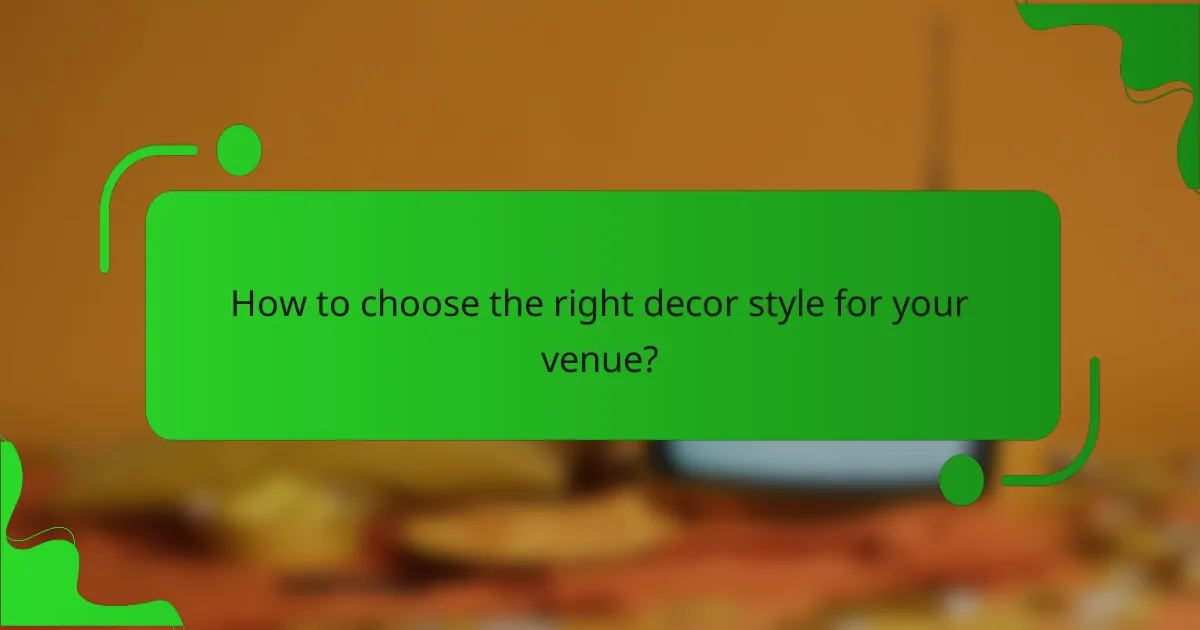Exploring unique decor styles in hidden gems reveals how distinctive atmospheres can elevate the visitor experience. These carefully curated themes not only reflect the essence of their surroundings but also create immersive environments that engage the senses and evoke emotions, making each visit truly memorable.

What are unique decor styles in hidden gems?
Unique decor styles in hidden gems create distinctive atmospheres that enhance the overall experience for visitors. These styles often reflect the character of the location, offering an immersive ambiance that sets them apart from mainstream venues.
Bohemian decor in boutique hotels
Bohemian decor in boutique hotels embraces a free-spirited and eclectic aesthetic, often featuring vibrant colors, mixed patterns, and an array of textures. This style typically includes vintage furniture, handcrafted items, and artistic elements that create a cozy and inviting environment.
When designing a bohemian space, consider incorporating local artisan crafts, lush plants, and layered textiles to enhance the ambiance. Avoid overly matching elements; instead, focus on creating a curated, lived-in feel that encourages relaxation and exploration.
Industrial chic in urban cafes
Industrial chic decor in urban cafes combines raw materials with modern design, creating a trendy yet comfortable atmosphere. Exposed brick walls, metal fixtures, and reclaimed wood are common features that contribute to this style, appealing to a contemporary audience.
To achieve an industrial look, prioritize open spaces with high ceilings and large windows. Incorporate vintage furniture and industrial lighting to add character, while ensuring the layout promotes social interaction among patrons.
Rustic farmhouse in countryside inns
Rustic farmhouse decor in countryside inns evokes a sense of warmth and nostalgia, often using natural materials like wood and stone. This style emphasizes simplicity and comfort, featuring cozy furnishings, vintage accents, and earthy color palettes that reflect the surrounding landscape.
For a successful rustic farmhouse design, focus on creating inviting communal spaces with large dining tables and comfortable seating. Incorporating local crafts and seasonal decor can enhance the charm and connect guests to the region’s heritage.
Art deco in historic theaters
Art deco decor in historic theaters showcases elegance and glamour, characterized by bold geometric shapes, rich colors, and luxurious materials. This style often includes intricate detailing and ornate fixtures that transport visitors to a bygone era of sophistication.
When restoring or designing an art deco theater, prioritize maintaining original architectural features while integrating modern amenities. Use rich fabrics and metallic accents to create a lavish atmosphere that enhances the theatrical experience.
Mid-century modern in local galleries
Mid-century modern decor in local galleries emphasizes clean lines, functional design, and a connection to nature. This style often features iconic furniture pieces, organic shapes, and a minimalist approach that allows artwork to take center stage.
To create a mid-century modern gallery, focus on open layouts with ample natural light. Incorporate statement furniture and neutral color schemes, allowing the art to shine while providing a comfortable viewing experience for visitors.

How do decor themes enhance ambiance?
Decor themes significantly enhance ambiance by creating a cohesive environment that influences how a space feels and functions. The right theme can evoke emotions, set the tone for interactions, and provide a unique experience that resonates with visitors.
Color schemes influence mood
Color schemes play a crucial role in shaping the mood of a space. Warm colors like reds and oranges can create a sense of energy and excitement, while cool colors such as blues and greens promote calmness and relaxation. When selecting a color palette, consider the purpose of the space and the feelings you want to evoke.
For example, a cozy café might benefit from warm, inviting tones, while a spa should lean towards soothing, tranquil hues. Aim for a balanced mix of colors to maintain visual interest without overwhelming the senses.
Lighting creates atmosphere
Lighting is essential for establishing the atmosphere of a room. Different types of lighting—ambient, task, and accent—serve various functions and can dramatically change how a space is perceived. Soft, diffused lighting can create a warm, intimate setting, while bright, direct lighting is ideal for workspaces.
Consider layering your lighting with dimmers and multiple sources to adjust the ambiance based on the time of day or activity. For instance, a restaurant may use low lighting for dinner service but brighter lights during lunch hours to enhance visibility and energy.
Furniture arrangement affects flow
The arrangement of furniture directly impacts the flow and functionality of a space. A well-planned layout allows for easy movement and encourages social interaction, while a cluttered or poorly arranged setup can create barriers and discomfort. When arranging furniture, consider the natural pathways people will take and the activities that will occur in the space.
For example, in a living room, placing seating in a circular formation can foster conversation, while a linear arrangement may be more suitable for a formal setting. Always leave enough space between pieces to avoid crowding and ensure comfort.

What are the experiences offered by unique decor?
Unique decor enhances experiences by creating immersive environments that engage the senses and evoke emotions. These experiences often combine aesthetics with functionality, transforming ordinary spaces into memorable venues.
Immersive dining in themed restaurants
Themed restaurants offer immersive dining experiences by incorporating decor that aligns with a specific concept, such as a historical era, a fantasy world, or a cultural theme. For instance, a pirate-themed restaurant might feature nautical decor, staff in costumes, and a menu inspired by maritime cuisine.
When choosing a themed restaurant, consider the overall ambiance and how it complements the food. Look for places that provide interactive elements, such as live performances or themed events, to enhance the dining experience. Reservations are often recommended, especially for popular venues.
Interactive art installations in cafes
Cafes with interactive art installations invite patrons to engage with the decor, often blurring the lines between art and everyday life. These spaces may feature murals that encourage photo opportunities or installations that change based on customer interaction, creating a dynamic atmosphere.
To fully enjoy these cafes, take time to explore the art and participate in any interactive elements. Many of these venues host events, such as art workshops or live performances, which can further enrich the experience. Check local listings for upcoming events to make the most of your visit.
Community events in creatively designed spaces
Creatively designed spaces often host community events that leverage their unique decor to foster connection and engagement. These events can range from art shows to workshops, encouraging participation and collaboration among attendees.
When attending community events, consider the design elements that enhance the experience, such as seating arrangements and lighting. Look for spaces that prioritize comfort and accessibility, ensuring that everyone can enjoy the event. Engaging with local artists or organizers can also provide deeper insights into the decor and its significance.

How to choose the right decor style for your venue?
Choosing the right decor style for your venue involves understanding your target audience, considering local influences, and evaluating the space’s functionality. A well-selected decor style enhances the overall experience and ensures that the ambiance aligns with your venue’s purpose.
Assess target audience preferences
Understanding your target audience’s preferences is crucial for selecting an appropriate decor style. Conduct surveys or gather feedback to identify what resonates with your guests, whether they prefer modern, rustic, or eclectic themes. Tailoring your decor to meet these preferences can significantly enhance guest satisfaction.
Consider demographic factors such as age, interests, and cultural backgrounds. For example, a younger crowd might appreciate vibrant colors and contemporary designs, while an older audience may favor classic and elegant styles.
Consider location and cultural influences
Your venue’s location plays a significant role in determining the decor style. Urban settings may lend themselves to modern or industrial themes, while rural areas might benefit from rustic or country-inspired decor. Incorporating local cultural elements can create a unique atmosphere that resonates with both locals and visitors.
Research regional trends and traditions to inform your decor choices. For instance, if your venue is in a coastal area, nautical themes with blues and whites could enhance the ambiance and appeal to guests’ expectations.
Evaluate space functionality and layout
The functionality and layout of your space are essential considerations when choosing a decor style. Assess how the decor will complement the existing architecture and flow of the venue. For example, open spaces may benefit from minimalistic decor to avoid clutter, while smaller venues might utilize cozy, intimate designs.
Ensure that the decor style supports the intended use of the space. If the venue hosts events like weddings or corporate meetings, choose decor that enhances the experience without overwhelming the guests. A practical approach is to create a mood board that visualizes how different styles will work within the space.

What are the benefits of unique decor styles?
Unique decor styles offer distinct advantages, including attracting a varied clientele and enhancing the overall ambiance of a space. These styles create an inviting atmosphere that encourages guests to engage and share their experiences.
Attracts diverse clientele
Unique decor styles can draw in a wide range of customers, from locals to tourists seeking something different. By incorporating elements that reflect local culture or artistic trends, establishments can appeal to various demographics.
For example, a cafe with vintage decor may attract nostalgia-driven patrons, while a modern art-themed restaurant might appeal to younger, trend-conscious visitors. This diversity can lead to increased foot traffic and higher overall sales.
Enhances social media presence
A visually striking decor style can significantly boost an establishment’s social media presence. Unique and photogenic spaces encourage guests to take photos and share their experiences online, increasing organic reach and engagement.
Consider creating designated photo spots or using vibrant colors and interesting textures to enhance the visual appeal. Establishments that actively promote their decor on platforms like Instagram often see a rise in followers and customer interest.
Creates memorable experiences
Unique decor styles contribute to creating memorable experiences for guests, making them more likely to return. An immersive environment can evoke emotions and foster connections, enhancing the overall visit.
For instance, a themed restaurant that transports diners to a different era or location can leave a lasting impression. Incorporating sensory elements, such as music or scent, alongside decor can further enrich the experience, encouraging patrons to share their stories with others.

How do local regulations affect decor choices?
Local regulations significantly influence decor choices by establishing guidelines for safety, aesthetics, and sustainability. These rules can dictate everything from color schemes to materials used, ensuring that decor aligns with community standards and environmental considerations.
Building Codes
Building codes are essential regulations that dictate structural integrity and safety standards for decor. They often specify fire safety measures, electrical installations, and accessibility features. For instance, in many U.S. cities, any decorative elements must comply with fire codes, which may limit the use of certain materials.
Historical Preservation Laws
In areas with historical significance, preservation laws may restrict decor choices to maintain the character of the neighborhood. These regulations can prevent modern alterations that clash with traditional aesthetics. For example, in European cities, property owners might be required to use specific paint colors or materials that reflect the historical period of the building.
Environmental Regulations
Environmental regulations can impact decor choices by promoting sustainable practices and materials. Many regions encourage or mandate the use of eco-friendly products, such as low-VOC paints and sustainably sourced furnishings. This not only helps reduce environmental impact but can also enhance the overall ambiance of a space.
HOA Guidelines
Homeowners’ Associations (HOAs) often have specific guidelines that dictate acceptable decor styles within a community. These rules can cover everything from exterior paint colors to landscaping choices. Adhering to HOA guidelines is crucial to avoid fines and ensure harmony within the neighborhood.



